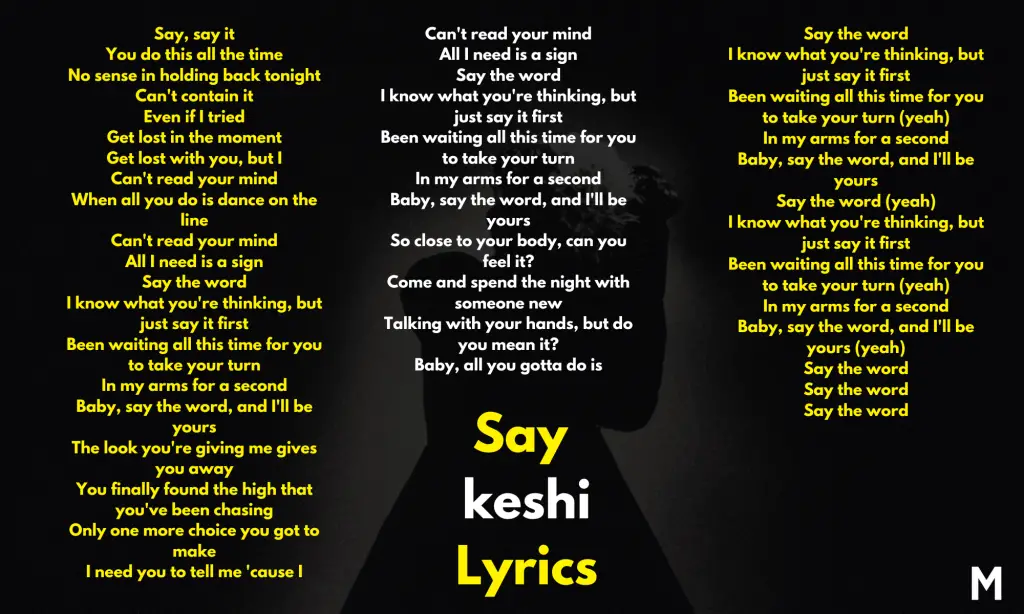Table of Contents
In Say, Keshi brings us into an intense moment of vulnerability, where he’s waiting for his partner to finally speak the words he knows they both feel. As someone who’s spent years diving into the classics of English literature and creative writing, I thought this song was a great excuse to explore how Keshi uses themes like unspoken love, tension, and the need for clear communication. While these are just my takeaways, I’m hoping to shed light on Say’s depth by exploring how classic poetry and literature handle these same themes.
Keshi’s path from self-producing music in his Houston bedroom to achieving global success and touring major venues has been full of growth and refinement. Known for his hauntingly introspective lyrics and genre-blending sound, Keshi’s work feels intensely personal, and Say is no exception. This track mixes a groovy, city-pop beat with lyrics that perfectly capture the push and pull of waiting for someone to say what they feel. Here, we’ll look at Say alongside the works of poets like Keats, Elizabeth Barrett Browning, and Pablo Neruda, seeing what literary history has to say about Keshi’s themes of longing, anticipation, and the need for spoken connection in love.
keshi Say Lyrics
keshi Say Meaning
“Can’t Read Your Mind / When All You Do Is Dance on the Line”
In these opening lyrics, the speaker is saying they can’t tell what their partner is really feeling. “Dance on the line” is a strong image here—it suggests the partner is always close to showing their true feelings but never quite does. This line shows us that the speaker is frustrated. They want to know how their partner really feels, and they want them to stop hiding behind hints.
This longing to know someone’s true feelings is something poets have written about for centuries. In her sonnet How Do I Love Thee, Elizabeth Barrett Browning lists all the ways she loves her partner, making sure there’s no room for doubt. She says, “I love thee to the depth and breadth and height / My soul can reach.” Here, Browning is completely open, leaving no mystery about her feelings. But in the song lyrics, the speaker is still guessing. They want the same kind of certainty Browning gives, but they’re not getting it.
So, “Can’t read your mind” really captures the feeling of being left out in the cold by someone who won’t speak up. Just like Browning’s clear expression of love, the speaker here is looking for that same level of honesty. They’re asking for words that would finally make everything clear between them and their partner.
“Say the Word / I Know What You’re Thinking, But Just Say It First”
These lyrics show the speaker’s need for a clear, spoken answer. “Say the word” is their way of asking their partner to take the lead, to put everything they feel into words. There’s a sense of vulnerability here. Even though the speaker thinks they know what their partner is feeling, they don’t want to move forward without hearing it confirmed first.
This plea for a verbal commitment is similar to Pablo Neruda’s words in If You Forget Me. In this poem, Neruda tells his partner that he needs them to show their love openly, saying, “If suddenly you forget me / do not look for me, for I shall already have forgotten you.” Neruda makes it clear that his love depends on mutual commitment—without words, he’ll pull away. The speaker in the song feels this way, too. They want their partner to “say it first,” showing they’re ready to fully commit.
Just like in Neruda’s poem, these song lyrics highlight the need for spoken affirmation in relationships. The speaker is asking for one word that would confirm everything, making it real and solid. Without it, the speaker feels like the relationship is stuck, not able to move forward until they hear the words.
“The Look You’re Giving Me Gives You Away”
Here, the speaker acknowledges that their partner’s body language shows how they feel, even if they won’t say it out loud. The line “The look you’re giving me gives you away” shows that the speaker can sense their partner’s interest through their actions, but that’s still not enough. They want something clearer and more reliable—something they can hold onto.
This need to move beyond looks and gestures echoes John Keats’s thoughts in his sonnet Bright Star. Keats writes, “Pillow’d upon my fair love’s ripening breast, / To feel for ever its soft fall and swell.” He wants to hold onto a single, perfect moment with his lover, but he also knows that moments and feelings can’t last forever. In the same way, the speaker in the song can see their partner’s love in their eyes and expressions, but they know that without words, those looks might fade or lose their meaning.
So, even though they feel connected through glances and expressions, the speaker wants more than that. Like Keats, they need something solid and lasting. The looks may “give away” the partner’s feelings, but only words can truly confirm them.
“So Close to Your Body, Can You Feel It?”
This line highlights the physical closeness between the speaker and their partner, but it also points to a distance between them. Even when they’re near each other, the speaker feels like something important is missing. “Can you feel it?” shows that the speaker is hoping their partner can sense the same deep connection, but without words, they’re left unsure if the partner feels it, too.
Elizabeth Barrett Browning’s Sonnet 43 connects to this desire for closeness that is also unspoken. In her poem, she talks about how she loves her partner “freely, as men strive for Right; / Purely, as they turn from Praise.” Her love is deep and almost spiritual, but she also takes time to say it aloud, giving voice to her feelings. For the speaker in the song, this closeness without words is just not enough. They need their partner to feel it, too, and to say it.
So, “So close to your body” speaks to the speaker’s wish for true intimacy, one that doesn’t rely only on closeness or gestures. They want words that will match the physical nearness, making the relationship feel real and lasting.
“Talking with Your Hands, But Do You Mean It?”
This line shows how the speaker is confused by the mixed messages from their partner. They see the gestures, they feel the physical closeness, but there’s still doubt. The speaker can’t be sure their partner is serious without hearing them say it. “Do you mean it?” sums up the central question of the song—the speaker needs verbal commitment to feel secure.
Pablo Neruda’s poem If You Forget Me also tackles the idea of needing a spoken commitment. He writes, “If little by little you stop loving me / I shall stop loving you little by little.” Here, Neruda is saying that love needs to be actively shown and expressed, or else it fades away. The speaker in the song is in the same position: they’re holding back, unsure if they can trust the gestures alone.
“Talking with your hands” suggests that actions and words both matter in love. Like Neruda, the speaker doesn’t want to move forward until they hear the truth out loud. They want assurance, knowing that words, not just gestures, will make the relationship solid and dependable.
“Say the Word / And I’ll Be Yours”
In the repeated chorus, the line “Say the word” is a clear, straightforward request. The speaker is saying they’re ready to commit fully, but they need their partner to take that final step. “And I’ll be yours” shows that they’re willing to give their heart to the relationship, but only if their partner confirms they feel the same way.
This need for confirmation reflects Keats’s wish in Bright Star to stay close to his lover, writing, “Still, still to hear her tender-taken breath, / And so live ever.” Keats knows that words and commitments make feelings last, just as the speaker in the song knows they need that spoken promise to feel secure.
Through this line, “Say the word,” the song captures the vulnerability of waiting for someone else to make the first move. The speaker’s willingness to be “yours” shows that they’re ready, but they need to know their partner is, too. Like in Keats’s poetry, words are essential to making love feel lasting and real.
Themes and Poetic Throughlines
At the heart of Keshi’s Say, we find a universal struggle: the need for honest, spoken words in love. The song’s speaker is aching for their partner to confirm what they both seem to feel, but instead, they’re left guessing—reading signals and “dancing on the line” without the verbal reassurance they need. This tension between physical closeness and emotional distance brings to mind John Keats’s Bright Star, Would I Were Steadfast as Thou Art, where Keats yearns for his love to be eternal, yet knows the limits of human connection.
Much like Keshi’s speaker, who wants clarity and permanence, Keats struggles with the fleeting nature of love when it’s left unspoken. With Say, Keshi taps into this timeless conflict, using his background in self-produced lo-fi to add depth to what seems like a simple plea for words, underscoring how crucial direct communication is in grounding a relationship.
Keshi’s lyrics also connect with the need for self-expression in Elizabeth Barrett Browning’s Sonnet 43, where she counts all the ways she loves her partner. Browning’s open expression contrasts with the silence Keshi’s speaker faces, highlighting the speaker’s frustration as they wait for a similar kind of assurance.
Like Browning, Keshi has built his music on emotional transparency, saying he wants his listeners to understand his truth—even if that truth sometimes gets reinterpreted in ways he doesn’t control. Keshi has mentioned how his work is often perceived as “sad boy music” or “emo,” labels he doesn’t necessarily claim, but accepts. Similarly, in Say, the speaker is in limbo, not fully knowing how they’re perceived by their partner and needing words to bring clarity to those silent signals.
Finally, the song’s theme of conditional love resonates with Pablo Neruda’s If You Forget Me, a poem that insists love must be mutual or it won’t last. In Say, Keshi’s speaker is waiting for verbal confirmation, a “sign” that would secure the connection, much like Neruda’s demand for explicit assurance. As Keshi’s music has evolved from bedroom pop to globally recognized work, he’s remained committed to keeping his lyrics personal and relatable, and Say is a strong example of this.
It’s about one of love’s most relatable struggles: wanting assurance, needing truth, and understanding that sometimes, only words will turn the unspoken into something real. By aligning Say with themes from these classic works, we see how Keshi’s storytelling fits within a long tradition of using words to bridge the gap between closeness and commitment.
The post Keshi Say Lyrics and Meaning: The Frustration of Silence, Through a Poetic Lens appeared first on Magnetic Magazine.






